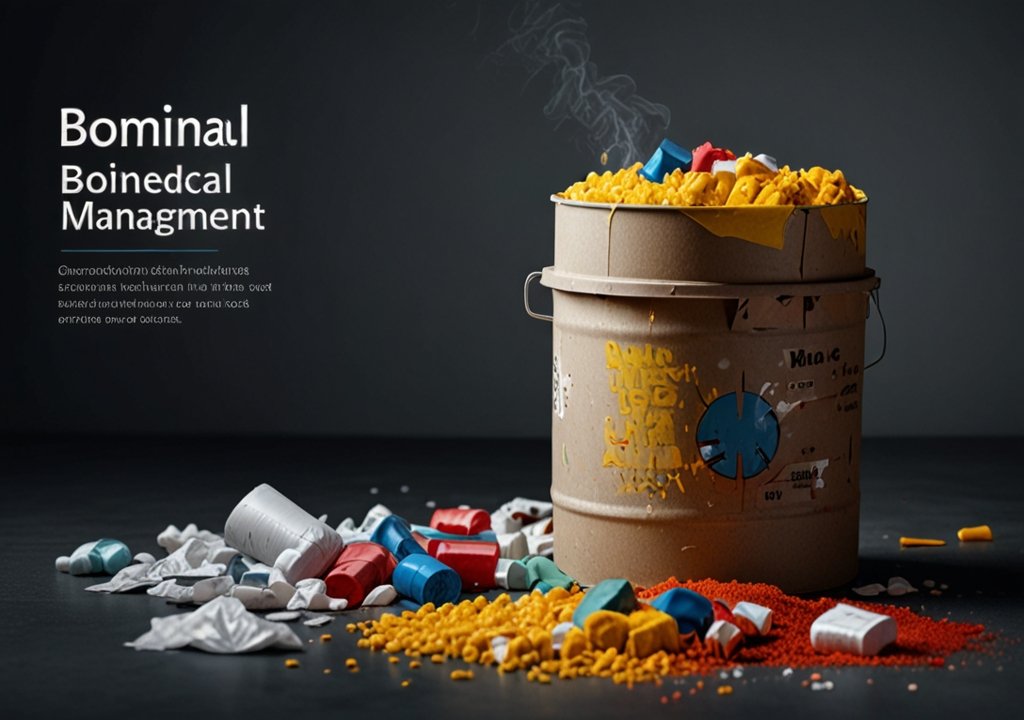Think up this: A child picks up a shiny object in a playground. It’s not a toy—it’s a discarded syringe. This unsettling scene isn’t fiction. In 2023, over 16 billion injections are administered globally annually, yet 30% of healthcare waste isn’t safely managed. Biomedical waste, if mishandled, becomes a silent predator. But what if a well-structured Biomedical Waste Management PPT could turn this danger into a solvable puzzle? Let’s decode this critical system, layer by layer.
The Hidden Danger in Healthcare: What Exactly is Biomedical Waste?
Biomedical waste isn’t just “hospital trash.” It’s a cocktail of hazards—discarded needles, blood-soaked bandages, amputated body parts, expired drugs, and chemical residues. Think of it as the dark side of medical progress: every life-saving treatment generates waste that, if mismanaged, can harm humans, animals, and ecosystems.
The 10 Faces of Hazard: Categories of Biomedical Waste
India’s Bio-Medical Waste Management Rules classify waste into ten types, each requiring tailored handling:
| Category | Examples | Color Code | Disposal Method |
|---|---|---|---|
| Human Anatomical Waste | Tissues, organs, body parts | Yellow | Incineration/Deep Burial |
| Sharps | Needles, scalpels, broken glass | Red | Autoclaving + Shredding |
| Infectious Solid Waste | Blood-soaked cotton, bandages | Yellow | Incineration |
| Chemical Waste | Formaldehyde, solvents | Brown | Chemical Neutralization |
| Pharmaceutical Waste | Expired antibiotics, vaccines | Blue | Return to supplier/Incineration |
| Genotoxic Waste | Cytotoxic drugs, cancer meds | Purple | Incineration (High Temp) |
| Radioactive Waste | Contaminated lab materials | Orange | Secure Storage + Specialized Disposal |
| Metallic Waste | Mercury thermometers, lead X-ray gear | White | Recycling after detoxification |
| Liquid Waste | Lab reagents, disinfectants | – | Chemical Treatment |
| Microbiology Waste | Cultures, specimen bags | Yellow/Red | Autoclaving + Incineration |
Why color-coding matters? Mixing waste types is like blending bleach and ammonia—deadly fumes guaranteed. Segregation at the source is the first shield against disaster.
Navigating the Maze: The 5-Step Biomedical Waste Management Process
Managing biomedical waste is like defusing a bomb—precision is non-negotiable. Let’s break down the process:
1. Segregation: The “Sort Your Laundry” Rule
Waste must be separated at the point of generation using color-coded bins. For instance:
- Red Bins: Sharps (needles, blades).
- Yellow Bins: Anatomical waste, infectious materials.
- Blue Bins: Glassware and metallic implants.
Common Pitfall: Overfilling bins. Solution? Use foot-operated lids and ¾ filling rule.
2. On-Site Collection: The Midnight Protocol
Waste is collected daily by gloved, masked staff using trolleys with spill-proof containers. Timing? Often post-operation hours to avoid patient exposure.
3. Storage: The 48-Hour Deadline
Storage areas must be rodent-proof, locked, and labeled with biohazard signs. In India, waste can’t be stored beyond 48 hours—monsoon or heatwave, no exceptions.
4. Transportation: GPS-Tagged Guardians
Authorized vehicles with refrigeration (for infectious waste) transport waste to treatment plants. GPS tracking ensures no “mystery detours.”
5. Treatment/Disposal: The Final Showdown
Each waste type meets its match:
- Incineration: For pathological and infectious waste (1,200°C destroys pathogens).
- Autoclaving: Steam sterilization for sharps and tools.
- Chemical Disinfection: Liquid waste gets neutralized.
From Hazard to Harmless: Treatment Methods Demystified
How do you kill a virus, melt a syringe, or neutralize toxic chemicals? Let’s compare:
| Method | Best For | Pros | Cons |
|---|---|---|---|
| Incineration | Infectious, pathological | Complete destruction of pathogens | Air pollution, high cost |
| Autoclaving | Sharps, tools | Reusable equipment, eco-friendly | Not for chemical/cytotoxic waste |
| Chemical Disinfection | Liquid waste | Cost-effective, quick | Chemical residue risks |
| Microwave Treatment | Organic waste | Low emissions, energy-efficient | High upfront investment |
Case Study: Mumbai’s Green Hospital reduced disposal costs by 20% by replacing incineration with autoclaving for 70% of its waste.

Rules of the Game: India’s Regulatory Framework
India’s Bio-Medical Waste Management Rules, 2016 are a playbook for safety. Key updates from 1998:
| Aspect | 1998 Rules | 2016 Rules |
|---|---|---|
| Coverage | Only hospitals | Vaccination camps, blood banks |
| Plastic Use | No guidelines | Ban on chlorinated plastic bags |
| Training | Annual for staff | Biannual mandatory workshops |
| Penalties | Vague fines | Up to ₹1,00,000 for non-compliance |
Real-World Impact: In 2019, a Delhi hospital was fined ₹5 lakh for dumping placenta in municipal bins.
Tech to the Rescue: Barcodes, RFID, and Smarter Waste Tracking
Imagine a waste bin texting you when it’s full. RFID tags and barcodes enable:
- Real-Time Tracking: Monitor waste from the ICU to the incinerator.
- Error Alerts: Get notified if a cytotoxic vial enters a general waste bin.
- Data Analytics: Predict waste generation peaks during flu season.
Chennai Med College cut segregation errors by 90% using RFID-tagged containers synced with their hospital app.
FAQs
1. What happens if biomedical waste isn’t segregated?
Mixing waste can lead to chemical reactions, infections, and rejected disposal loads. Think of it as tossing a lit match into a fireworks factory.
2. Incineration vs. Autoclaving—which is better?
Incineration destroys; autoclaving disinfects. Use incineration for body parts, autoclaving for scalpels.
3. Can pharmaceutical waste be incinerated?
Yes, but high-temperature incinerators (≥1,200°C) are needed to prevent toxic fumes.
4. How often should healthcare staff undergo waste management training?
As per 2016 Rules, every 6 months. Knowledge decays faster than radioactive waste!
5. Are dental clinics covered under BMW Rules?
Absolutely. Even a single dental chair generates sharps and infectious waste.
6. What’s the penalty for dumping biomedical waste illegally?
Fines up to ₹1 lakh and potential license cancellation.
7. Can we reuse sterilized sharps?
Never. Autoclaved sharps are shredded to prevent reuse.
3 Steps to Revolutionize Your Waste Management Today
- Audit Your Bins: Are color codes visible? Is segregation happening at the source?
- Go Digital: Explore RFID tagging for high-risk wards.
- Train, Then Train Again: Turn waste protocols into muscle memory for staff.
Biomedical waste management isn’t just compliance—it’s a moral duty. With the right Biomedical Waste Management PPT, you’re not just presenting slides; you’re safeguarding futures. Ready to turn hazard into harmony? The next syringe discarded could save a life, not endanger it.
YOU MAY ALSO LIKE
DignoTech Revolutionizing Remote Dermatological and Dental Care











